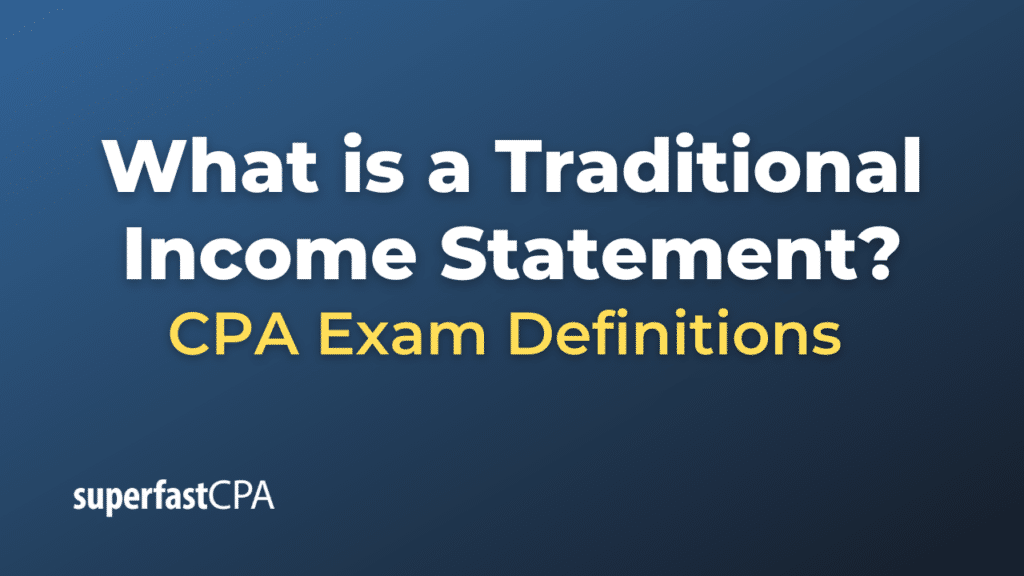Traditional Income Statement
A traditional income statement, also referred to as a single-step income statement, presents a company’s revenues and expenses in a straightforward manner, without breaking them down into multiple categories or operations. In essence, it consolidates all revenues and gains into one group and all expenses and losses into another group. The difference between the two is then presented as the net income (or net loss).
The format of a traditional income statement is simpler than the multi-step income statement, which categorizes expenses by function and provides multiple levels of income (e.g., gross profit, operating income).
Here’s a basic structure of a traditional income statement:
DREAMY COMPANY INC.
Income Statement
For the Year Ended December 31, 2023
REVENUES AND GAINS:
Sales Revenue $XXX,XXX
Interest Income $XX,XXX
Gain from Sale of Assets $X,XXX
--------------------------------------------
Total Revenues and Gains $XXX,XXX
EXPENSES AND LOSSES:
Cost of Goods Sold $XXX,XXX
Selling Expenses $XX,XXX
Administrative Expenses $XX,XXX
Interest Expense $X,XXX
Loss from Lawsuits $X,XXX
--------------------------------------------
Total Expenses and Losses $XXX,XXX
Net Income (Total Revenues and Gains minus Total Expenses and Losses) $XX,XXXKey features of a traditional income statement:
- Simplicity: It consolidates all sources of income and all expenses without going into much categorization. This makes it easier to read but may not provide as much detail or insights as a multi-step income statement.
- Net Income Calculation: It determines the net income by subtracting the total expenses and losses from the total revenues and gains.
- Lack of Gross Profit: Unlike the multi-step income statement, the traditional income statement does not separately list out gross profit, which is the profit from sales after subtracting the cost of goods sold.
While the traditional income statement provides a straightforward look at a company’s profitability, it may not be as useful for management or external stakeholders who want more detailed insights into the company’s operations, cost structure, or profitability sources. For this reason, many companies, especially larger ones or those in complex industries, prefer to use a multi-step income statement.
Example of a Traditional Income Statement
Let’s use a fictional company, “Moonlight Bookstore Inc.”, to illustrate a traditional income statement.
MOONLIGHT BOOKSTORE INC.
Income Statement
For the Year Ended December 31, 2023
REVENUES AND GAINS:
Sales Revenue $500,000
Interest Income from Bank Deposits $5,000
Gain from Sale of Old Store Equipment $3,000
-----------------------------------------------
Total Revenues and Gains $508,000
EXPENSES AND LOSSES:
Cost of Goods Sold (Books Purchased) $320,000
Store Rent $50,000
Employee Salaries $80,000
Marketing and Promotions $20,000
Utilities (Electricity, Water) $10,000
Interest Expense on Loans $5,000
Loss from Damaged Inventory $3,000
-----------------------------------------------
Total Expenses and Losses $488,000
Net Income (Total Revenues and Gains minus Total Expenses and Losses) $20,000In this example:
- Moonlight Bookstore Inc.” had total revenues and gains of $508,000 for the year. This includes their primary revenue source, which is the sales of books, and other revenues such as interest income and gains from the sale of assets.
- Their total expenses and losses for the year amounted to $488,000. This encompasses everything from the cost of the books they sold (Cost of Goods Sold) to their store rent, employee salaries, and other operational expenses.
- The difference between their total revenues and gains and their total expenses and losses results in a net income of $20,000, which represents the profit they made for that year.
The traditional income statement format, as shown, provides a basic overview of the company’s financial performance for the year, consolidating all forms of income and expenses into two main categories.













